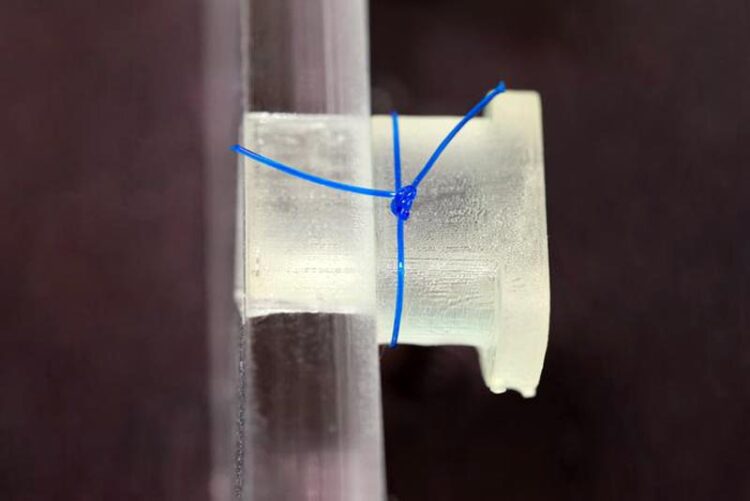Study reveals mechanics of the ideal surgical knot

Surgical knot tied on a rigid support
Credit: Alain Herzog / EPFL
EPFL researchers have published a first study on the mechanics of surgical knots, with results that could be used to train surgeons to tie stronger, safer sutures – a skill that usually requires years of practice to master.
Think about the last time you tied your shoe: maybe you tied it tightly, or tied multiple knots to ensure the laces wouldn’t come undone. You likely relied on intuition to tell you how much tension to apply to keep the laces from untying, without pulling hard enough to break them.
Perhaps surprisingly, surgeons also take an intuitive approach to knotting sutures. While simple square and granny sliding knots are often used in surgery, it takes years to master them so that they stay in place without loosening or breaking. Much mathematical research has been done on knot topology and geometry, but little is known about knot mechanics in the context of physical variables, like the material properties of knotted filaments.
“It’s astonishing to think how much we rely on knots, when we don’t really understand how they work,” says Pedro Reis, head of the Flexible Structures Lab in the School of Engineering (Institute of Mechanical Engineering). Reis and PhD student Paul Johanns teamed up with Lausanne-based plastic surgeon Samia Guerid to lead a first physics-based study – recently published in Science Advances – on the mechanics of surgical knots, and exactly what properties influence their strength.
“Understanding surgical knot mechanics can raise awareness among experienced surgeons, be incorporated into training programs, and advance robotic surgery by enabling more effective knot-tying capabilities,” says Guerid. “Such knowledge could also influence the development of suture materials that enhance slippage resistance in sliding knots.”
The power of plasticity
Reis, an avid climber, has a personal interest in secure knots and has conducted several previous studies on knot mechanics. He explains that many knots can be described as free-ended structures that provide a holding force, with their functionality dictated by the variables of topology, geometry, elasticity, contact, and friction. But for the study of surgical knots, Reis and his colleagues considered a key sixth factor: polymer plasticity of the suturing filament.
The strength of sutures made from polypropylene filaments used in surgery depends on the tension applied during the tying of the knot (pretension). This pretension permanently deforms, or stretches the filament, creating a holding force. Too little pretension causes the knot to come undone; too much snaps the filament.
The team analyzed 50-100 knots tied by Guerid, and found that the surgeon was able, thanks to her years of experience, to intuitively target the pretension ‘sweet spot’. Using precision experiments, X-ray micro-computed tomography, and computer simulations, the scientists defined a threshold between ‘loose’ and ‘tight’ knots, and uncovered relationships between knot strength and pretension, friction, and number of throws.
“Surprisingly, despite the complex interplay between all six factors, we observed a simple, robust emergent behavior vis-à-vis knot strength. But we still don’t have a predictive model to fully explain the relationship between knot pretension and strength, which seems to be consistent, even outside surgical knots. We’re already looking into this question.”
A training tool for surgeons…and robots
The team’s findings could be a valuable tool for training surgeons, as they could allow the parameters of a secure knot to be translated into practical guidelines. While experience would remain important, the idea is that safe knot-tying could be taught using predictive models, rather than intuition gained only through years of practice.
“Our data gives us a recipe for determining the ideal pretension and number of throws, for example, depending on the type of filament used,” Reis says
“The lack of physics-based analysis has been a limitation,” Guerid adds. “Quantifiable data on knot mechanics could be integrated into training programs to assess the tensile strength of each knot, ensuring trainees acquire necessary skills for successful surgeries. The data could also facilitate development of robotic surgery via the programming of robotic systems.”
Journal: Science Advances
DOI: 10.1126/sciadv.adg8861
Article Title: The strength of surgical knots involves a critical interplay between friction and elasto-plasticity
Article Publication Date: 7-Jun-2023
Media Contact
All latest news from the category: Medical Engineering
The development of medical equipment, products and technical procedures is characterized by high research and development costs in a variety of fields related to the study of human medicine.
innovations-report provides informative and stimulating reports and articles on topics ranging from imaging processes, cell and tissue techniques, optical techniques, implants, orthopedic aids, clinical and medical office equipment, dialysis systems and x-ray/radiation monitoring devices to endoscopy, ultrasound, surgical techniques, and dental materials.
Newest articles
Faster, more energy-efficient way to manufacture an industrially important chemical
Zirconium combined with silicon nitride enhances the conversion of propane — present in natural gas — needed to create in-demand plastic, polypropylene. Polypropylene is a common type of plastic found…

Energy planning in Ghana as a role model for the world
Improving the resilience of energy systems in the Global South. What criteria should we use to better plan for resilient energy systems? How do socio-economic, technical and climate change related…

Artificial blood vessels could improve heart bypass outcomes
Artificial blood vessels could improve heart bypass outcomes. 3D-printed blood vessels, which closely mimic the properties of human veins, could transform the treatment of cardiovascular diseases. Strong, flexible, gel-like tubes…





















